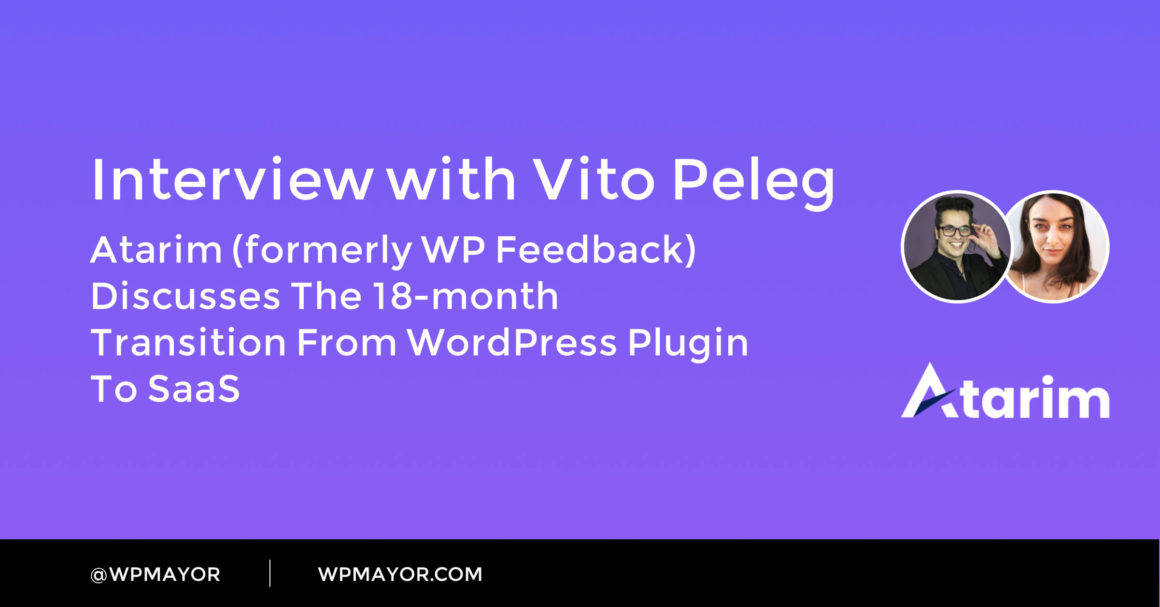Q: Hi Vito! For those readers who are not familiar with Atarim (formerly WP FeedBack), can you introduce the plugin, who it’s for, and what made it one of the top plugins for managing projects?
Hey Gaby! It’s great to be back on the blog ❤
Atarim is a web agency management system designed to enable collaboration with clients, communication within the team, and free up most of the back and forth and bottlenecks that are involved in delivering web services. These might include gathering content, approving designs, and providing support to care plan clients.
We started as a standalone plugin (WP FeedBack). Now, we’re a cloud-based application with a plugin dedicated solely to the end interface. It’s similar to the way Zendesk or Intercom have plugins that integrate with WordPress to perform specific functions.
What used to be the standalone plugin has now evolved into the client interface. It encourages clients to use the product they paid for – the website itself. The plugin can be used for the entire process of the build, as well as for support. Rather than being pushed to multiple different tools, clients can access one interface for all their needs.
Meanwhile, the Agency Dashboard is the place where freelancers and agency team members log in every morning to see what project tasks need to be carried out and access pending support requests.
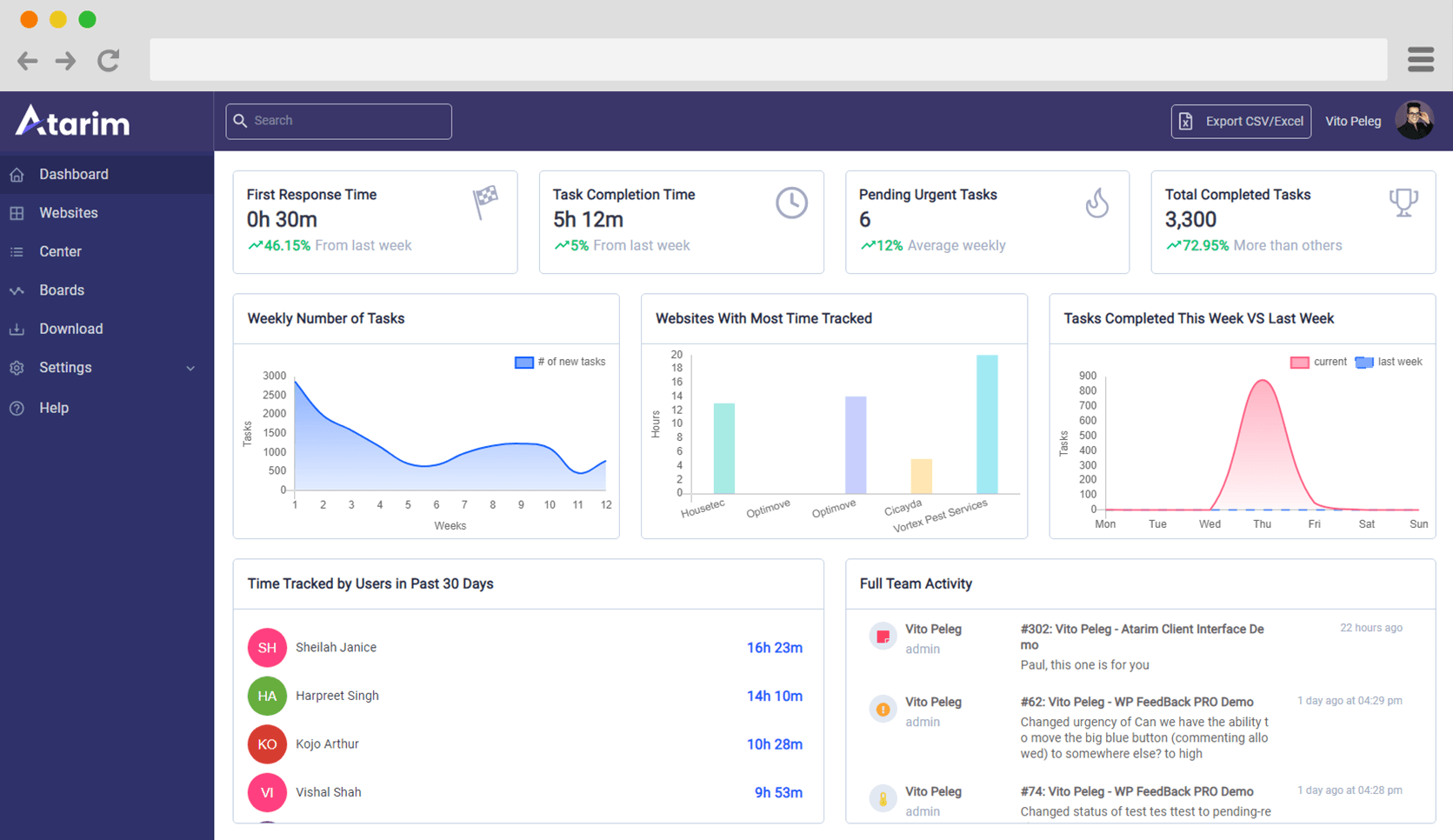 The Atarim dashboard
The Atarim dashboardOur WordPress management platform includes unique tools created to support the day-to-day activity of web professionals specifically. These include:
- Our visual collaboration tools
- Auto logins
- Auto image optimizations of client resources,
- Team activity tracking
- Time tracking
- Estimates
- … and a lot more (150+ features)
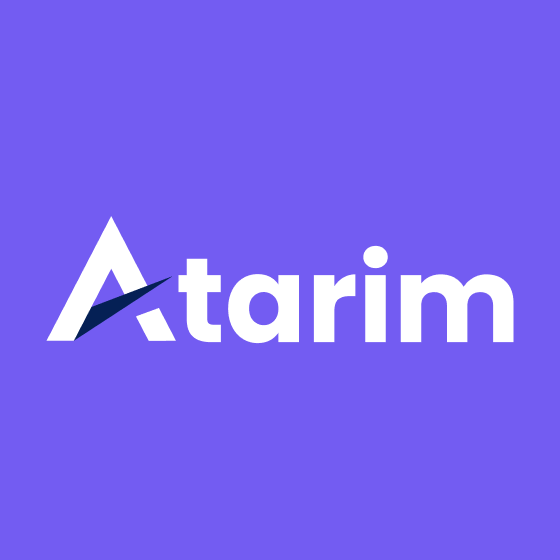
Atarim
The only agency management platform dedicated to website design & development.
Get started
Q: As time went by, what pushed you to create a cloud-based application?
I set out on this journey to create a simple plugin to help my own agency collaborate with clients. It worked like magic! Not only did it reduce a lot of time wasted on day-to-day tasks, but it also reduced a whole lot of stress. I decided to bring this product to market in the form of WP FeedBack. This seems like years ago, but it’s only been 18 months since the launch.
The awesome traction we received early on helped us identify that client collaboration was just a symptom of a bigger issue within our space. Agencies and freelancers jumping around between 7-15 different tools, all patched together, to deliver a basic website project.
Even worse, agencies introduce most of the tools to the client within the span of a few weeks of the project start date. This means that clients often get lost in the process, feeling helpless, trying to get to the launch date.
This, in turn, causes the agency or freelancer to be all over the place. A situation like this will affect the bottom line, the profitability of the business, and the mental state of the agency owner and their team. I’ve been there myself and it’s not easy.
So, I decided to expand our vision beyond the basic feedback tool we started with. We created a centralized environment to manage the work. A tool specifically designed for web agencies and freelancers.
That is what the Agency Dashboard is all about.
Q: Atarim boasts that it reduces 80% of users’ project delivery time. How do you measure this and how did you make this happen?
I didn’t believe this was possible at first. But when hearing some of our user’s results, we started to track the time it took to complete the task.
We then compared these results with those of other agencies, including my own, that were tracking time on other systems. That, along with project completion stats, compared to deep surveys we ran in our industry.
The standard basic website takes between 5-8 weeks to complete, from the discovery call to launch. Users who implemented the system fully, are completing the same steps in 10 days or less!
Thinking about it, when I first started building websites 20+ years ago, creating a long scrollable homepage in pure HTML and CSS took me about 10 hours. Now, with page builders, the same and sometimes even better result can be done within 30-60 minutes.
That is the same impact we’re bringing to project delivery time and tackling support requests.
Our approach is to address the dead time of communication cycles between the client and within the team. This, along with automating a whole lot of the day-to-day repetitive and mind-numbing tasks we all do.
Over the past 18 months, we’ve been reducing 1 click at a time, resulting in less back and forth. I’m very proud of the results our clients are getting for their businesses and their bottom line.
That being said, a lot of time is invested in the training of our users. This takes the form of weekly coaching calls, projects delivery courses, and 1-on-1 calls to help them implement new ideas and get the same results. Those that do get there are those that don’t usually stay in their fragmented ways. Their stats show a reduction of between 20-30% in time spent on projects and support.
Q: From my personal experience, teams tend to use a number of management systems which can get tricky to monitor.
Would you say this is one of the biggest issues you wanted to address with Atarim?
This is the core of the problem right there.
The agency owner, freelancer, or project manager acts like those call center women from the ’50s. Bouncing communications from one side to the next and logging in and out of tools all day long. This quickly becomes the biggest bottleneck of the business. Team members end up wasting loads of time instead of focusing on things that really move the needle.
Most web professionals can probably relate to this insane workflow:
You get a message from a client via email, Whatsapp, Facebook Messenger, phone call, or Zoom. Then you go through the task of listing the request on Asana or Trello, then post about it to the team on Slack, after which you wait for a reply. Provided there aren’t any additional questions that need to be passed on to the client (which there usually are) the team member will then need to find the domain of the site, log in, and then navigate to the relevant page to inspect the change or request. Once they’re there, the team member makes the change and posts about it on Slack, so the agency owner can go back to Asana and Trello, move the task around, before reaching back to the client to let them know it’s done.
This is crazy.
With our system, the client adds a request. The plugin takes an automated screenshot, along with the screen size and browser version. The team can see the tasks based on the sites that are assigned to them. With one click, they get to the exact location of the request, logging them in along the way.
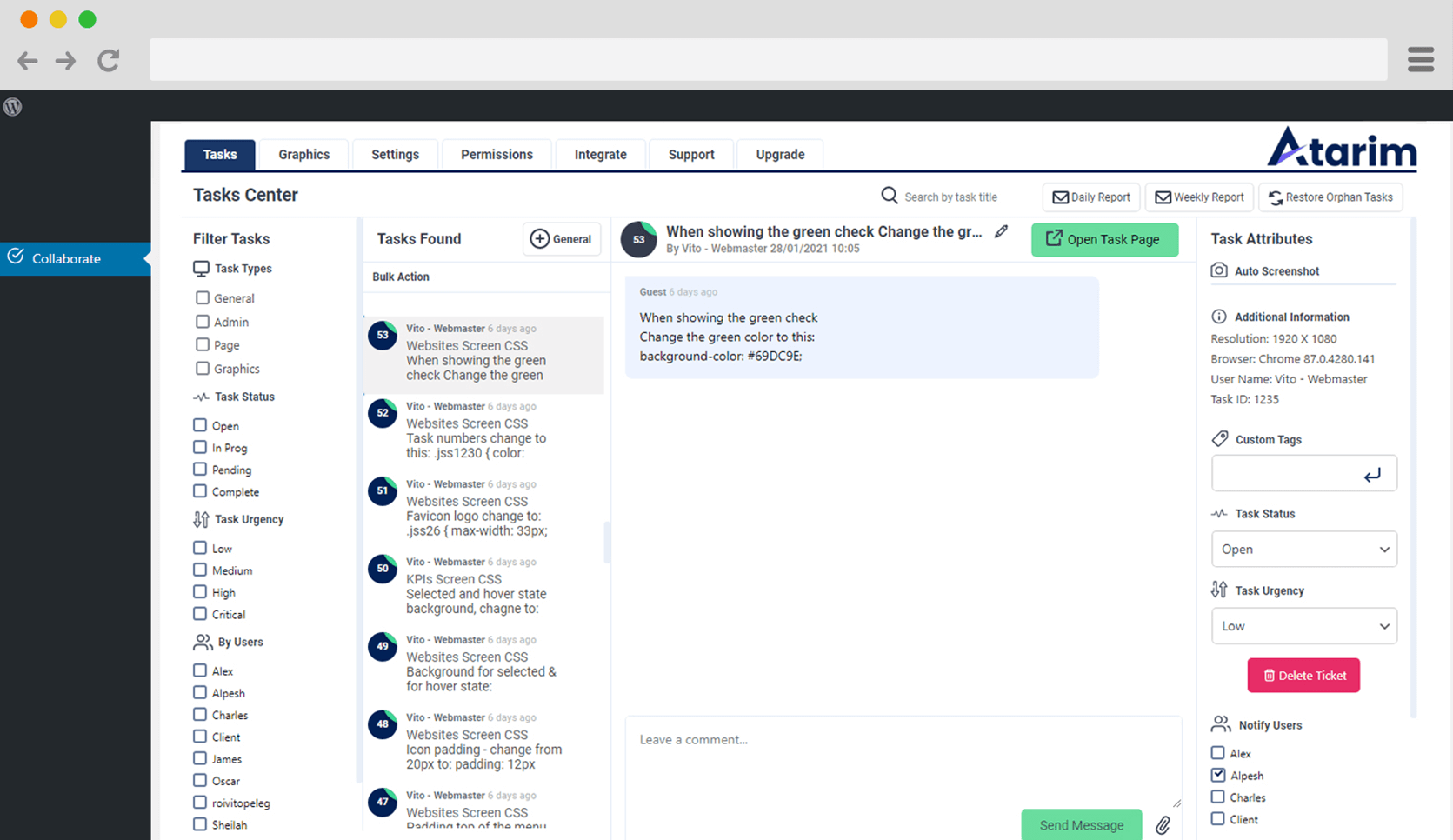 Atarim’s client interface plugin
Atarim’s client interface pluginWhen they are done, they then mark the task as complete. This moves it to the relevant position in the Kanban board and notifies the clients with an automated message.
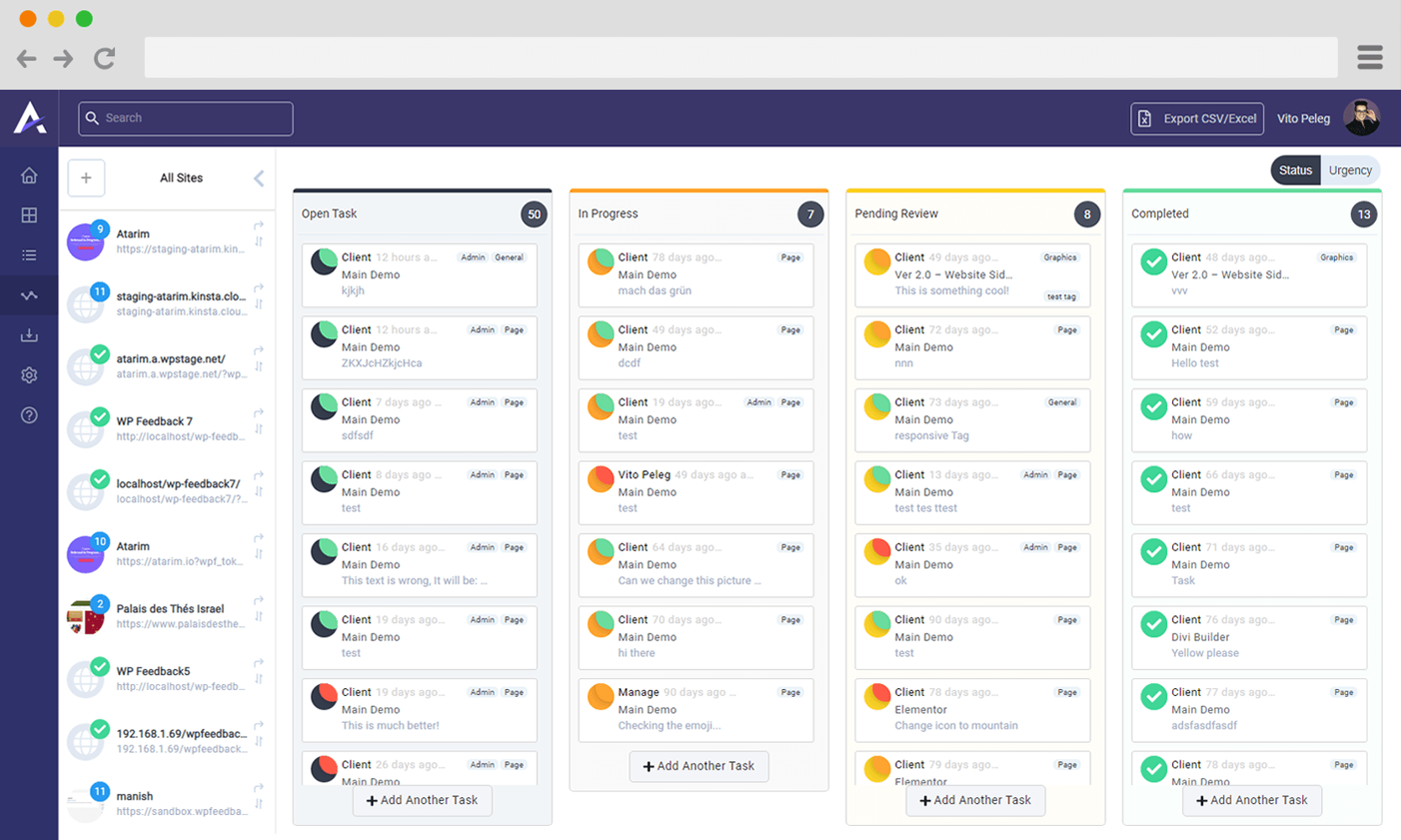 Atarim’s management boards
Atarim’s management boards Atarim’s team activity feeds
Atarim’s team activity feedsWe took the bottleneck out of the equation.
Q: What other typical and tedious processes are you tackling?
Another awkward process can take the following format:
The client is expected to face a blank Google doc to provide text-based content, with no visual representation of context. Then they need to log in to Dropbox and drop their images there. Next, they would email, WhatsApp, or text the agency to check. The team then views the Google doc and logs in to Dropbox to download the assets. Next, they need to process them through TinyPNG, and finally log in to the website to upload the image into the media folder.
With our WordPress management platform, the client leaves the text on the page itself, where there is context, along with the images they need to provide. The team member gets notified automatically. All that’s left is for the team member to click the image (which has already been optimized for the web) to push it into the media folder.
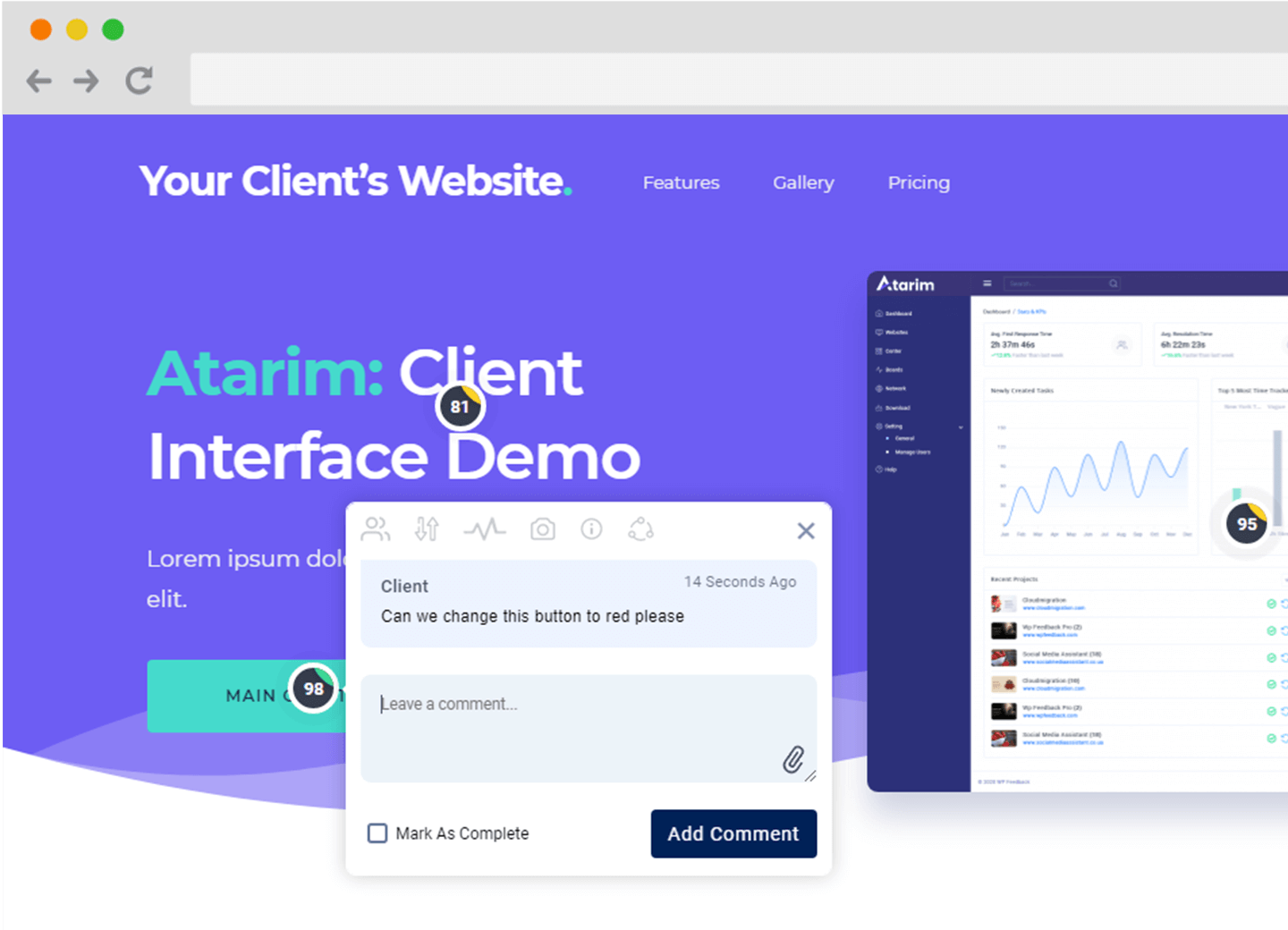 Atarim’s client interface showing a client suggestion
Atarim’s client interface showing a client suggestionWith this system, there’s no need to train the client to use multiple tools and logins. It significantly reduces the back and forth for both sides. It allows both the client and the agency to stick to the creative work that needs to be done.
Q: What drove you to transition from a WordPress plugin to SaaS?
Even though the development and maintenance costs are higher for a cloud-based application, I wanted to put the needs of our users first. I wanted to give them an experience that no other generic tool could provide.
We’re jumping into the deep end, competing with companies that are funded by hundreds of millions combined. These include Asana, ClickUp, Basecamp, Zendesk, Dropbox, Slack, Harvest, InVision…
I believe that by being the only WordPress management platform that is focused specifically on web freelancers and agencies, we can consolidate the work, tackle problems that the big players will never address, and create, for the first time, a unified experience for our industry.
We can’t do that by being a standalone WordPress plugin, considering the millions of variations that our users have on their stacks. Between different hosts, plugin combinations, WP Mail issues, performance concerns and so on, achieving the roadmap we have set for ourselves would be very difficult as a plugin.
So we renamed our plugin the “Client Interface Plugin” to help our users understand that the website collaboration tool is for the clients – encouraging them to use and engage with the product they bought (the website itself). Meanwhile, the “Agency Dashboard” is meant to be the hub for optimized work between all the different websites.
Q: Rebranding can come with quite a few challenges.
How did you tackle a name change and do you think this will help emphasize the growth and evolution that your plugin has gone through?
Tell me about it ? ?
Rebranding is a process not a single day, single week, or even a single month’s process.
There’s so much to change and adapt so we’ve been working on this step for 6 months and even now that it’s out in the open, there are still many mentions out there and we’re tackling them one by one.
I always tell my team and our users that this is a journey we’re all taking together. We evolve with their needs and the needs of the business.
Over the past 18 months, we’ve evolved so much, with the 150+ features we built and the Agency Dashboard, we are no longer just WP and no longer just Feedback. Therefore, the name WP FeedBack started to hold us back.
We were being compared to basic tools that are out there. This made sense for ver 1.0 but was no longer valid after the huge advances and investment we put into the management platform.
I like the name Atarim because it allows the product to evolve without the restriction of a literal name. But it also has a deeper meaning to me since “Atarim” means “websites” in Hebrew, my native language.
It feels like this places us in the position we want to be, competing with the big players that drive agencies at the moment.

Atarim
The only agency management platform dedicated to website design & development.
Get started
Keep reading the article at WP Mayor. The article was originally written by Gabriella Galea on 2021-03-03 07:00:00.
The article was hand-picked and curated for you by the Editorial Team of WP Archives.

